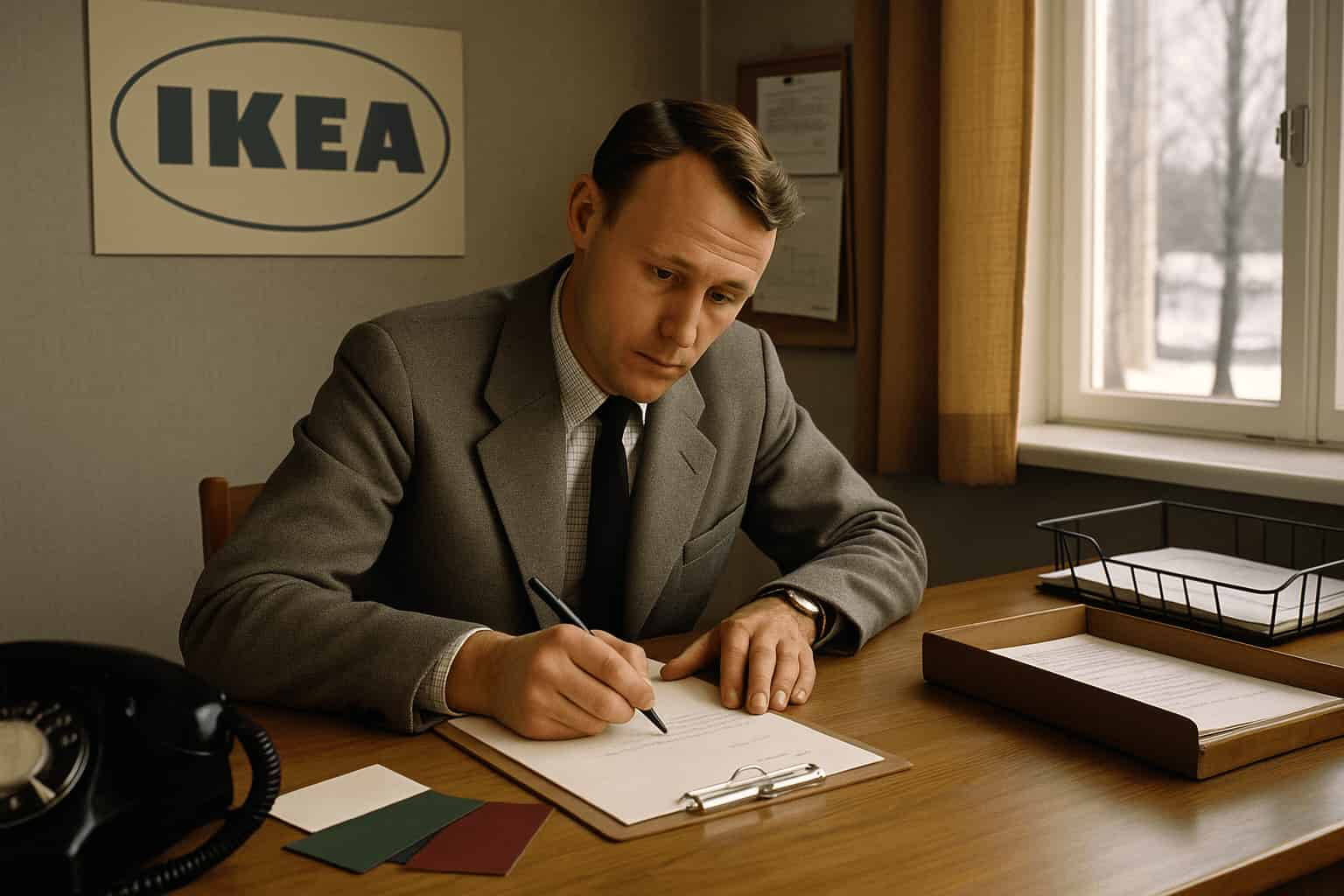Table of contents
Ingvar Kamprad transformed a childhood of poverty and struggle into one of the world’s most successful business empires. Born on a struggling Swedish farm in 1926, this dyslexic teenager would revolutionize the furniture industry and create IKEA, a global phenomenon that democratized home design. His story represents the ultimate rags-to-riches journey, proving that extraordinary success can emerge from the most humble beginnings.
The Swedish entrepreneur’s path from selling matches as a five-year-old to building a multinational corporation worth billions demonstrates the power of persistence, innovation, and unwavering determination. Kamprad’s legacy extends far beyond furniture retail, encompassing philanthropy, business philosophy, and a revolutionary approach to making quality products accessible to everyone. This remarkable journey offers invaluable lessons for aspiring entrepreneurs and business leaders worldwide.
Early Life & Struggles

Feodor Ingvar Kamprad entered the world on March 30, 1926, in the rural province of Småland, Sweden, where poverty cast a long shadow over his family’s existence. His grandfather, Achim Erdmann Kamprad, had fled economic hardship in post-industrial Germany, purchasing a timber estate near Agunnaryd after seeing an advertisement in a hunting magazine. The family’s financial struggles reached a tragic climax when Achim took his own life, unable to bear the burden of mounting debts and an unaffordable mortgage.
Young Ingvar’s grandmother managed to save the family farm, but the specter of financial ruin haunted the household. The 449-hectare property, though the largest in the area, provided little comfort for a family grappling with economic uncertainty. Kamprad’s father, Feodor, worked tirelessly to maintain the farm, while his mother, Berta Linnea Matilda Nilsson, struggled to keep the family together during these difficult times.
School presented additional challenges for the young Kamprad, who battled dyslexia in an educational system that showed little understanding of learning differences. Traditional academic subjects proved frustrating and difficult, leading to poor performance that disappointed his parents. His father’s harsh criticism cut deep, with the elder Kamprad once telling his son he would “never amount to anything.” These words would fuel Ingvar’s determination to prove his worth through entrepreneurial success.
Despite academic struggles, Kamprad displayed remarkable business instincts from an extraordinarily young age. At five years old, he began selling matches to neighbors, demonstrating an innate understanding of profit margins by purchasing bulk quantities in Stockholm and selling them individually at competitive prices. This early venture revealed his natural talent for identifying opportunities and maximizing returns, skills that would prove invaluable in his future business endeavors.
Turning Points
A Seventeen-Year-Old’s First Big Step
Kamprad’s entrepreneurial journey reached a pivotal moment when his father, recognizing his son’s academic achievements despite his learning challenges, presented him with a cash reward at age seventeen. This gesture of recognition and financial support provided the young entrepreneur with the capital needed to formalize his business ambitions. Rather than spending the money on typical teenage pursuits, Kamprad invested it in registering a mail-order business that would eventually become a global empire.
Founding IKEA

On a fateful day in 1943, seated at his uncle Ernst’s kitchen table, seventeen-year-old Kamprad officially founded IKEA. The company name represented a clever combination of his initials (Ingvar Kamprad) with those of his family’s farm (Elmtaryd) and the nearby village where he was raised (Agunnaryd). This personal touch reflected his deep connection to his roots and the humble beginnings that would always influence his business philosophy.
Early Business Challenges and Innovations
Initially, IKEA operated as a general merchandise business, selling everything from picture frames and jewelry to nylon stockings and ballpoint pens. Kamprad utilized telephone sales and catalog distribution to reach customers across Sweden, gradually building a reputation for quality products at affordable prices. His dyslexia, initially viewed as a disadvantage, actually contributed to his innovative approach to product naming, as he found numbers difficult to remember and instead used Swedish names for products.
Overcoming Boycotts and Creating IKEA’s Model
The business faced its first major crisis in the early 1950s when established furniture retailers, threatened by IKEA’s low prices, pressured Swedish suppliers to boycott the upstart company. Rather than surrender to this coordinated attack, Kamprad demonstrated the resilience and innovative thinking that would define his career. He responded by having IKEA design its own merchandise and establishing relationships with foreign suppliers, particularly in Poland and other Eastern European countries.
Vertical Integration Begins
This forced innovation proved transformative, as it gave IKEA complete control over its product design and manufacturing processes. The company could now create furniture specifically designed for affordability and functionality, rather than simply reselling existing products. This strategic pivot laid the foundation for IKEA’s future success and established the principle of vertical integration that would become central to the company’s operations.
Breakthrough Success
The Flat-Pack Revolution

The year 1956 marked a revolutionary moment in furniture retail history, though it began with a simple problem faced by IKEA designer Gillis Lundgren. After creating a veneered coffee table called the Lövet, Lundgren discovered it wouldn’t fit in his Volvo station wagon for a crucial photoshoot. His practical solution—removing the table legs and packing them separately with the tabletop—accidentally birthed the flat-pack furniture industry that would transform global retail.
A Redefined Business Model
This seemingly minor incident sparked a complete reimagining of furniture manufacturing and distribution. Lundgren’s modified design became IKEA’s first successful mass-produced flat-pack product, dramatically reducing shipping costs and storage requirements. Customers could now easily transport furniture home in their own vehicles, eliminating delivery fees and making quality furniture accessible to a broader market segment than ever before.
Business Benefits and Customer Loyalty
The flat-pack innovation solved multiple business challenges simultaneously. Manufacturing costs decreased significantly due to more efficient use of materials and simplified production processes. Shipping expenses plummeted as compact packaging allowed more products per container. Storage became more efficient as flat-packed items required minimal warehouse space. Most importantly, customers embraced the concept enthusiastically, appreciating both the cost savings and the satisfaction of assembling their own furniture.
Expansion of Physical Stores
IKEA’s first showroom opened in Almhult, Sweden, in 1953, followed by the first retail outlet in 1958. These physical locations allowed customers to see and test furniture before purchasing, building confidence in the flat-pack concept. The stores featured distinctive blue and yellow roofs that would become globally recognizable symbols of the IKEA brand, while innovative layouts encouraged customers to envision complete room designs rather than individual pieces.
Self-Service Store Philosophy
The breakthrough success extended beyond mere product innovation to encompass a complete retail philosophy. IKEA pioneered the concept of self-service furniture shopping, where customers could browse extensive showrooms, make selections, and collect their purchases from warehouse areas. This approach reduced labor costs while empowering customers to make informed decisions at their own pace, creating a shopping experience that was both efficient and enjoyable.
Key Business Moves
Transferring Ownership to a Foundation

Kamprad’s strategic vision extended far beyond product innovation to encompass revolutionary business structures that would ensure IKEA’s long-term success and independence. In 1982, he made the unprecedented decision to transfer ownership of IKEA to the Stichting INGKA Foundation, a Dutch-registered charitable organization. This move protected the company from potential acquisition attempts while ensuring its mission would continue long after his death.
Governance and Control
The foundation structure served multiple purposes, providing tax advantages while maintaining family control over strategic decisions. Kamprad retained significant influence as chairman of the foundation, but the legal structure prevented any single individual or entity from gaining complete control over the company. This innovative approach to corporate governance became a model for other family-owned businesses seeking to balance growth with independence.
Expanding Globally
Global expansion accelerated throughout the 1960s and 1970s as IKEA opened stores across Western Europe and eventually worldwide. The company’s franchise system allowed for rapid international growth while maintaining consistent brand standards and operational procedures. Each new market required careful adaptation of products and marketing strategies to local preferences, but the core IKEA concept of affordable, functional design proved universally appealing.
Embracing the Digital Age
The digital revolution of the early 2000s presented both challenges and opportunities for the traditional retail model. IKEA embraced e-commerce in 2000, launching online sales that complemented its physical stores rather than competing with them. The company’s catalog, which by 2003 had achieved the world’s largest annual print run, transitioned seamlessly to digital formats while maintaining its role as a primary marketing tool.
Leadership Transition
Succession planning became increasingly important as Kamprad aged, leading to a gradual transition of leadership responsibilities to his three sons. In 2013, at age 87, he resigned from the board of Inter IKEA Holding SA, with his youngest son Mathias assuming the chairman role. This carefully orchestrated transition ensured continuity of leadership while allowing the founder to step back from day-to-day operations while remaining available for strategic guidance.
Legacy & Lessons Learned
A Life of Impact

When Ingvar Kamprad passed away peacefully at his home in Småland on January 27, 2018, at age 91, he left behind more than just a furniture company—he had created a global cultural phenomenon that transformed how people think about home design and retail shopping. His death marked the end of an era, but his influence continues to shape business practices and consumer behavior worldwide through the enduring success of IKEA and its foundational principles.
The IKEA Foundation’s Mission
The IKEA Foundation, established with Kamprad’s vision of “creating a better everyday life for as many people as possible,” continues his philanthropic mission by focusing on children’s rights and climate change initiatives. This commitment to social responsibility reflects his belief that successful businesses have an obligation to contribute positively to society, a philosophy that has inspired countless other entrepreneurs to integrate charitable giving into their business models.
Entrepreneurial Principles That Endure
Kamprad’s approach to business offers invaluable lessons for aspiring entrepreneurs, particularly his emphasis on frugality, innovation, and customer focus. His famous manifesto, “A Testament of a Furniture Dealer,” outlined principles that remain relevant today: waste of resources is a mortal sin, simplicity is a virtue, and the customer’s needs must always come first. These values guided IKEA’s growth from a small Swedish company to a global empire with nearly 500 stores worldwide.
Democratizing Design
The democratization of design represents perhaps Kamprad’s most significant contribution to modern society. By making well-designed furniture accessible to people of all economic backgrounds, he challenged the notion that good design was a luxury reserved for the wealthy. This philosophy influenced countless other industries and helped establish the principle that quality and affordability need not be mutually exclusive.
A Model for Future Founders
For entrepreneurs seeking to build lasting businesses, Kamprad’s story demonstrates the importance of persistence in the face of adversity, the value of turning constraints into opportunities, and the power of maintaining a clear vision while adapting to changing circumstances. His journey from a dyslexic farm boy selling matches to the founder of a global empire proves that extraordinary success can emerge from the most humble beginnings when combined with determination, innovation, and an unwavering commitment to serving others.
The Revolutionary Business Model
Disrupting Furniture Retail

Kamprad’s genius extended beyond product innovation to encompass a complete reimagining of the retail furniture experience. Traditional furniture stores operated on high-margin, low-volume principles, catering primarily to affluent customers who could afford both premium prices and professional delivery services. IKEA’s revolutionary approach flipped this model entirely, focusing on high-volume, low-margin sales that made quality furniture accessible to middle-class families across the globe.
Redefining the In-Store Experience
The self-service concept represented a radical departure from conventional retail practices. Instead of relying on commissioned salespeople to guide customers through limited showroom displays, IKEA created vast warehouse-style stores where shoppers could explore room settings, test furniture, and make independent purchasing decisions. This approach reduced labor costs significantly while empowering customers to take their time and envision how products would fit into their own homes.
Creating a Complete Customer Journey
Kamprad understood that successful retail required more than just competitive pricing—it demanded a complete customer experience that made shopping enjoyable and stress-free. IKEA stores became destinations rather than mere shopping venues, featuring Swedish restaurants, children’s play areas, and carefully designed traffic flows that guided customers through the entire product range. These innovations transformed furniture shopping from a chore into an adventure, encouraging longer visits and higher purchase volumes.
Logistics and Inventory Strategy
The company’s approach to inventory management revolutionized retail logistics. By maintaining large quantities of flat-packed products in on-site warehouses, IKEA could offer immediate availability for most items while minimizing storage costs. Customers appreciated being able to take purchases home immediately rather than waiting weeks for delivery, while the company benefited from reduced inventory carrying costs and simplified distribution networks.
Quality Through Simplicity
Quality control became a cornerstone of IKEA’s success, with rigorous testing procedures ensuring that affordable products met high durability standards. The company’s design philosophy emphasized functionality over ornamentation, creating furniture that served practical needs while maintaining aesthetic appeal. This focus on essential features rather than luxury details allowed IKEA to achieve cost targets without compromising on performance or safety.
Global Expansion and Cultural Adaptation
IKEA’s international expansion required careful navigation of diverse cultural preferences, regulatory environments, and economic conditions. Kamprad recognized that successful globalization demanded more than simply replicating the Swedish model in foreign markets—it required thoughtful adaptation while maintaining core brand values and operational efficiencies.
Each new market presented unique challenges that tested the company’s adaptability and cultural sensitivity. In Germany, IKEA had to overcome skepticism about Swedish quality and design preferences that favored traditional styles over modern minimalism. The company responded by emphasizing product durability and gradually introducing German consumers to Scandinavian design principles through carefully curated showroom displays and targeted marketing campaigns.
American expansion proved particularly challenging due to different housing styles, consumer preferences, and competitive landscapes. IKEA’s European-sized furniture often seemed too small for American homes, while the self-service concept initially confused customers accustomed to traditional retail experiences. The company adapted by offering larger product variants, providing more customer service support, and investing heavily in education about the IKEA shopping process.
Asian markets required even more significant adaptations, as cultural preferences for furniture styles, materials, and shopping behaviors differed dramatically from European norms. IKEA learned to incorporate local design elements while maintaining its core aesthetic, offering products made from materials preferred by local consumers and adapting store layouts to accommodate different shopping patterns and family structures.
The company’s success in diverse markets demonstrated the universal appeal of affordable, functional design when properly adapted to local preferences. IKEA’s ability to maintain brand consistency while respecting cultural differences became a model for other multinational retailers seeking to expand globally without losing their core identity.
Innovation and Design Philosophy

Kamprad’s commitment to democratic design—making good design accessible to everyone—drove continuous innovation in materials, manufacturing processes, and product development. The company’s design teams worked within strict cost constraints, forcing creative solutions that often led to breakthrough innovations benefiting the entire furniture industry.
Material innovation became a hallmark of IKEA’s approach, with designers constantly seeking alternatives to expensive traditional materials without compromising functionality or appearance. The development of particleboard and other engineered wood products allowed IKEA to create furniture that looked like solid wood while maintaining affordability. These innovations eventually became industry standards, transforming furniture manufacturing worldwide.
Manufacturing partnerships with suppliers across the globe enabled IKEA to leverage regional advantages in materials, labor costs, and specialized expertise. The company’s long-term relationships with suppliers created mutual benefits, as IKEA’s volume commitments allowed partners to invest in advanced equipment and training while ensuring consistent quality and delivery schedules.
Product development cycles at IKEA emphasized iterative improvement rather than revolutionary changes, reflecting Kamprad’s belief in continuous refinement over dramatic innovation. Design teams regularly updated existing products based on customer feedback, manufacturing improvements, and changing lifestyle needs, ensuring that the product range remained relevant and competitive.
The company’s approach to sustainability evolved gradually from cost-driven efficiency to genuine environmental stewardship. Kamprad recognized that resource conservation aligned with both cost control objectives and growing consumer awareness of environmental issues. IKEA’s investments in renewable energy, sustainable materials, and circular economy principles demonstrated how environmental responsibility could enhance rather than compromise business success.
Personal Philosophy and Management Style
Kamprad’s personal values profoundly influenced IKEA’s corporate culture and management practices. His commitment to frugality extended beyond cost control to encompass a broader philosophy about resource utilization and social responsibility. The famous story of Kamprad flying economy class and staying in budget hotels while building a billion-dollar empire illustrated his belief that personal extravagance was incompatible with business success.
The concept of “lagom”—a Swedish word meaning “just the right amount”—permeated IKEA’s approach to everything from product design to corporate governance. This philosophy encouraged moderation and balance, avoiding both excess and inadequacy in pursuit of optimal solutions. Kamprad believed that sustainable success required finding the perfect balance between competing priorities rather than maximizing any single metric.
Employee empowerment represented another core element of Kamprad’s management philosophy. Despite IKEA’s size and global reach, the company maintained a relatively flat organizational structure that encouraged initiative and innovation at all levels. Kamprad believed that front-line employees often had the best insights into customer needs and operational improvements, making their input invaluable for continuous improvement.
The company’s approach to failure reflected Kamprad’s own experiences overcoming adversity and learning from mistakes. IKEA’s culture encouraged calculated risk-taking and viewed failures as learning opportunities rather than career-ending disasters. This philosophy fostered innovation and adaptability, enabling the company to respond quickly to changing market conditions and customer preferences.
Kamprad’s emphasis on long-term thinking over short-term profits distinguished IKEA from many publicly traded competitors focused on quarterly earnings. The foundation structure he created insulated the company from pressure to maximize immediate returns, allowing for patient capital allocation and strategic investments that might not pay off for years or decades.
Technological Evolution and Digital Transformation

IKEA’s embrace of technology evolved gradually under Kamprad’s leadership, reflecting his cautious approach to change and emphasis on proven solutions over cutting-edge innovations. The company’s early adoption of computer-aided design and manufacturing systems improved product development efficiency while maintaining the hands-on approach that characterized IKEA’s culture.
The transition to digital catalogs and online shopping required careful balance between technological capabilities and customer preferences. IKEA’s catalog had become a cultural phenomenon in many countries, with annual distribution reaching hundreds of millions of copies worldwide. The company’s digital strategy complemented rather than replaced print materials, recognizing that different customers preferred different shopping methods.
E-commerce implementation proceeded methodically, with extensive testing and gradual rollouts ensuring that online experiences met IKEA’s quality standards. The company recognized that furniture purchases often required physical inspection and testing, making pure online retail insufficient for many customers. The integration of digital tools with physical stores created omnichannel experiences that leveraged the strengths of both approaches.
Mobile technology adoption accelerated as smartphones became ubiquitous, enabling IKEA to develop apps that enhanced in-store experiences while providing convenient access to product information and availability. Augmented reality features allowed customers to visualize furniture in their own homes before purchasing, reducing return rates while increasing customer confidence in their selections.
The company’s approach to data analytics emphasized customer service improvement over invasive tracking or manipulation. IKEA used purchase data and customer feedback to optimize inventory management, improve product designs, and enhance store layouts, always with the goal of making shopping more convenient and enjoyable rather than maximizing sales through psychological manipulation.
Social Impact and Corporate Responsibility
Kamprad’s vision of creating “a better everyday life for the many people” extended beyond furniture retail to encompass broader social responsibility and community impact. The IKEA Foundation’s work in developing countries reflected his belief that successful businesses had obligations to contribute positively to society, particularly in areas where they operated or sourced materials.
Educational initiatives became a significant focus of IKEA’s social responsibility efforts, with programs designed to improve literacy, vocational training, and entrepreneurship in communities worldwide. The company recognized that sustainable business success required healthy, educated communities capable of participating in the global economy as both workers and consumers.
Environmental stewardship evolved from a cost-saving measure to a core business principle as IKEA recognized the long-term risks of resource depletion and climate change. The company’s investments in renewable energy, sustainable forestry, and circular economy principles demonstrated how environmental responsibility could enhance rather than compromise business performance.
Supply chain responsibility became increasingly important as IKEA’s global sourcing network expanded into developing countries with varying labor standards and environmental regulations. The company developed comprehensive supplier codes of conduct and monitoring systems to ensure that cost advantages didn’t come at the expense of worker welfare or environmental protection.
Community engagement initiatives in markets worldwide reflected IKEA’s understanding that successful retail required strong relationships with local stakeholders. The company’s investments in local infrastructure, education, and economic development created goodwill while building the customer base and supplier networks necessary for long-term success.
Lessons for Modern Entrepreneurs
Kamprad’s journey from poverty to global success offers timeless lessons for entrepreneurs facing their own challenges and opportunities. His story demonstrates that extraordinary achievements often emerge from ordinary circumstances when combined with persistence, innovation, and unwavering commitment to serving others.
The importance of turning constraints into opportunities represents perhaps the most valuable lesson from Kamprad’s experience. His dyslexia led to the Swedish naming system that became an IKEA trademark. Supplier boycotts forced the innovation that gave IKEA competitive advantages. Size limitations in his designer’s car sparked the flat-pack revolution that transformed an entire industry.
Customer focus remained central to every major decision throughout IKEA’s growth, reflecting Kamprad’s belief that sustainable success required genuine value creation rather than clever marketing or financial engineering. The company’s continued growth decades after its founding demonstrates the power of building businesses around authentic customer needs rather than short-term profit maximization.
Long-term thinking distinguished Kamprad from many entrepreneurs focused on quick exits or immediate returns. His willingness to invest in capabilities, relationships, and market development that might not pay off for years or decades enabled IKEA to build sustainable competitive advantages that competitors found difficult to replicate.
Finally, Kamprad’s commitment to social responsibility and environmental stewardship demonstrates how businesses can create positive impact while achieving commercial success. His legacy proves that profit and purpose need not be mutually exclusive when approached with creativity, commitment, and genuine concern for stakeholder welfare.
- From Orphanage to Empire: The Leonardo Del Vecchio Story
- From Poverty to Polo: The Extraordinary Rags-to-Riches Journey of Ralph Lauren
- From Brooklyn Projects to Billion-Dollar Empire: The Extraordinary Rags-to-Riches Journey of Howard Schultz
- From Fax Machines to Fortune: Sara Blakely’s Extraordinary Journey to Billionaire Status
- From Desert Sands to Billion-Dollar Empire: The Extraordinary Journey of Mohed Altrad
Wikipedia https://en.wikipedia.org/wiki/Ingvar_Kamprad

